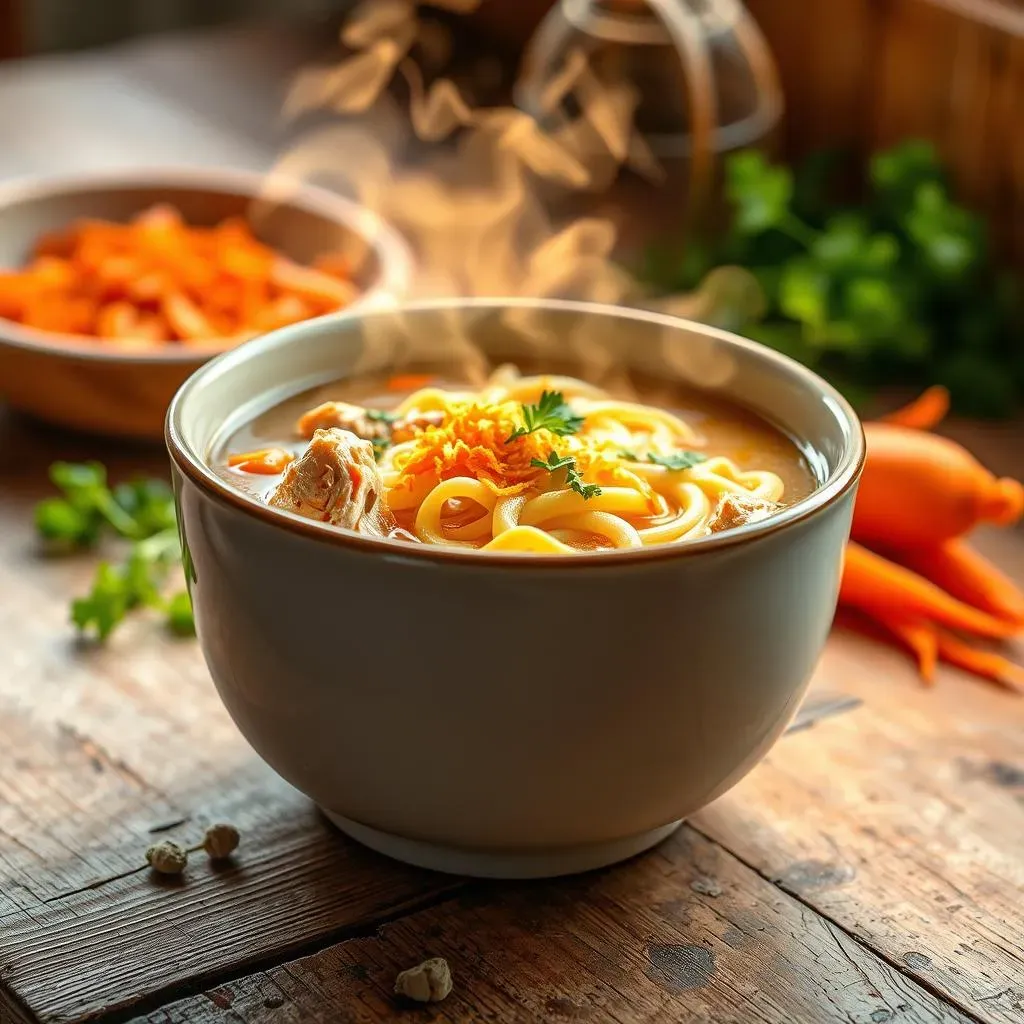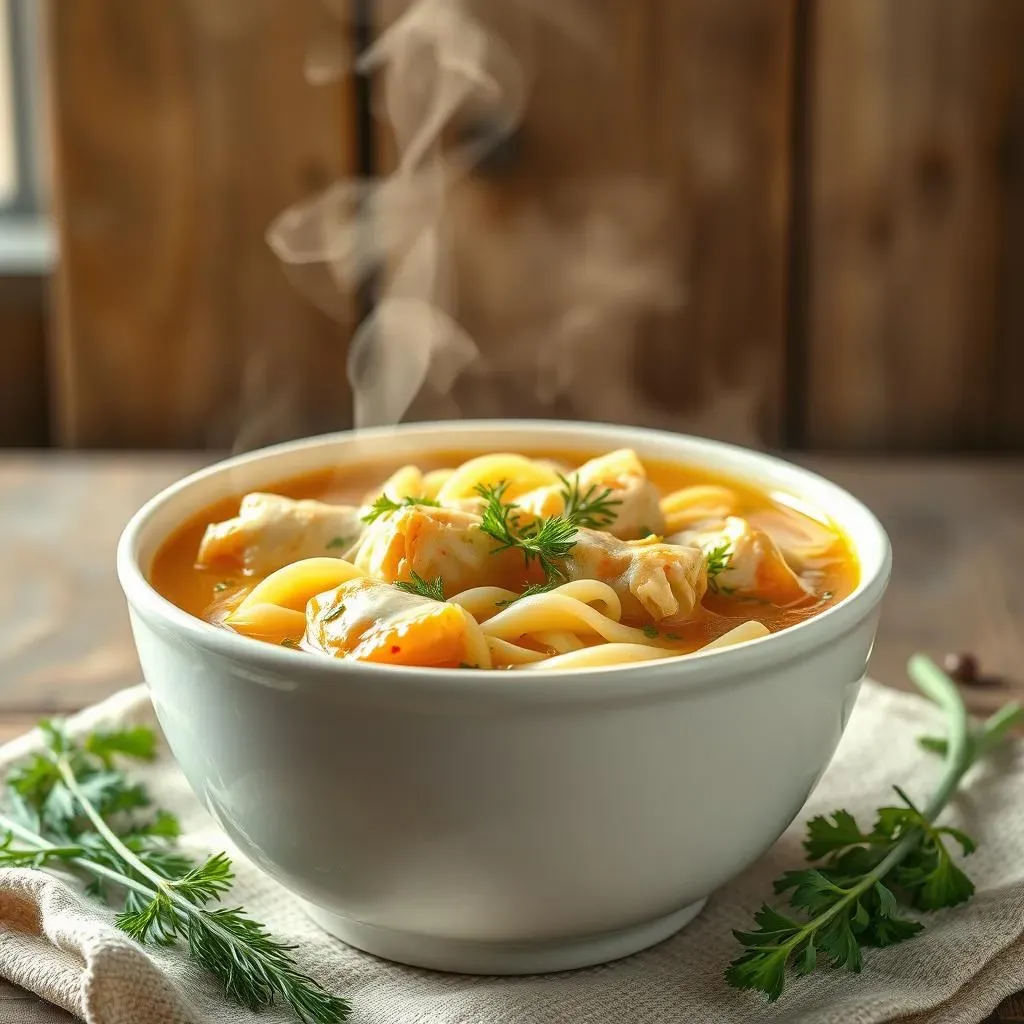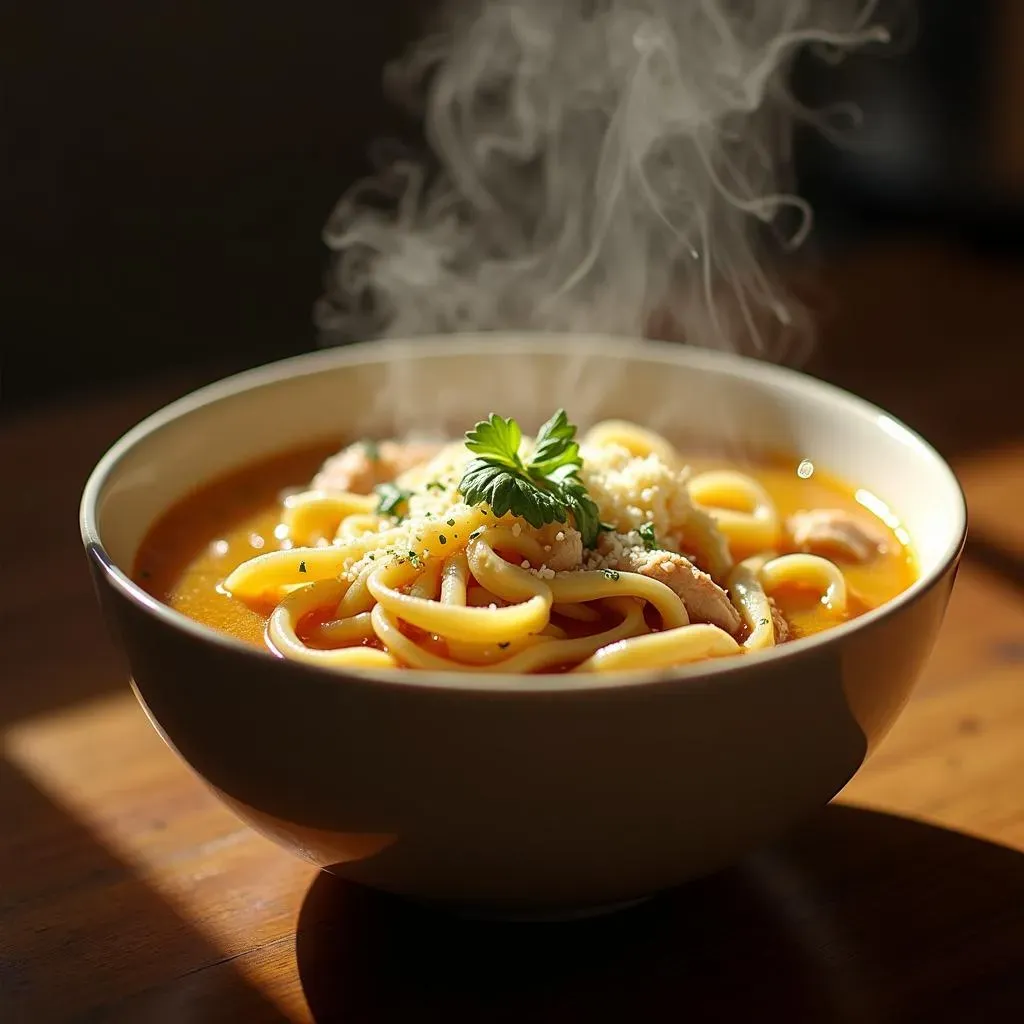Table of Contents
Ever stared into a bowl of chicken noodle soup, wishing it packed more punch? You're not alone. Many of us have been there, spoon in hand, wondering how to make chicken noodle soup taste better. It's easy to end up with a bland, watery concoction when you're aiming for that comforting, flavorful classic. But fear not, because today, we're turning that ho-hum soup into a culinary masterpiece. This isn't about complicated techniques or fancy ingredients. Instead, we'll explore simple, effective ways to elevate your soup game. We'll start by focusing on building a rich, flavorful broth. Then, we'll talk about the chicken itself and how to make it shine. Next, we'll dive into the world of noodles and how they can make or break your soup. Finally, we’ll look at those last-minute additions that can take your soup from good to great. So, get ready to transform your chicken noodle soup from average to amazing, because by the end of this article, you'll know exactly how to make chicken noodle soup taste better.
The Secret to a Flavorful Broth: How to Make Chicken Noodle Soup Taste Better

The Secret to a Flavorful Broth: How to Make Chicken Noodle Soup Taste Better
Start with the Right Bones
Okay, so you want a broth that sings, not whispers? Forget those sad, pre-cut chicken pieces. We're talking bones, my friend. Chicken carcasses, backs, necks – these are your flavor goldmines. They’ve got marrow and connective tissue that melt down into the most delicious, rich broth you can imagine. Think of it like this: you wouldn't build a house with flimsy cardboard, would you? Same goes for soup. You need a strong foundation, and that means using the right bones. I remember the first time I used a whole chicken carcass, it was like a flavor explosion in my mouth. My family thought I suddenly became a Michelin star chef.
Don’t be afraid to roast the bones first. It adds a layer of depth that you just can’t get any other way. Toss them in the oven at 400°F (200°C) for about 20-30 minutes until they get a nice golden brown. The roasting process brings out the sugars and creates this amazing umami flavor that will make your soup taste like it’s been simmering for hours, even if it hasn’t. It’s a total game changer, trust me. It’s like unlocking a secret level in a video game, but for your soup.
Vegetables: The Unsung Heroes
Now, let's talk veggies. Onions, carrots, and celery are the holy trinity of soup aromatics. But don’t just toss them in whole. Roughly chop them – the more surface area, the more flavor they release. Sauté them in a bit of olive oil before adding the bones and water. This caramelizes them a little, bringing out their natural sweetness and adding another layer of flavor to the broth. Think of it as giving the vegetables a little spa treatment before they go to work. It might seem like a small step, but it makes a huge difference.
Don’t skimp on the herbs either. A few sprigs of thyme, parsley, or a bay leaf can add a subtle complexity that elevates the entire pot. Remember, we’re building flavor, layer by layer, like a delicious lasagna. And just like lasagna, each ingredient plays an important role. The vegetables aren't just there to look pretty; they're there to contribute to the symphony of flavors.
Ingredient | Why it's Important |
|---|---|
Chicken Bones (Roasted) | Richness, depth of flavor |
Onions, Carrots, Celery (Sautéed) | Aromatic base, sweetness |
Thyme, Parsley, Bay Leaf | Subtle complexity, herbal notes |
Low and Slow is the Way to Go
Finally, patience is key, my friend. Don’t rush the broth. Let it simmer gently for at least a couple of hours, or even longer if you have the time. The longer it simmers, the more those flavors will meld together and intensify. It’s like letting a good wine breathe. The low and slow method allows all those delicious compounds to extract from the bones and vegetables, creating a broth that is far beyond the watery stuff you might be used to. It's a waiting game, but it's worth it. Trust me, your taste buds will thank you.
So, there you have it. The secret to a flavorful broth isn’t really a secret at all. It’s about using the right ingredients, treating them with respect, and giving them the time they need to work their magic. It’s about building a solid foundation for your soup, one delicious layer at a time. Now go forth and make some amazing broth!
Boosting the Chicken Power: How to Make Chicken Noodle Soup Taste Better

Boosting the Chicken Power: How to Make Chicken Noodle Soup Taste Better
Alright, so we've got a killer broth base, but let's be real – chicken noodle soup needs some seriously tasty chicken. Don't just settle for bland, boiled pieces. We're going to take that chicken from zero to hero. First off, consider using bone-in, skin-on chicken thighs or drumsticks. They have more flavor than breasts, and the skin adds richness. Think of it like this: chicken breasts are like the quiet kid in class, while thighs are the life of the party. And let's face it, we want a party in our soup bowl. I remember my grandma always used bone-in chicken, and it made all the difference. It's like a secret weapon for flavor.
Now, here's the kicker: sear that chicken before adding it to the broth. Get a pan hot with a little oil and brown those pieces on all sides. This creates a beautiful crust and locks in the juices. It’s like giving the chicken a tan, but way more delicious. The Maillard reaction, that's the fancy science name for it, does wonders. It's the same reason grilled steaks taste so good. It adds a depth and complexity that simmering alone just can't achieve. This step is crucial, don't skip it! It's like adding a secret code to the recipe.
Chicken Part | Flavor Profile | Best Use |
|---|---|---|
Bone-in Thighs/Drumsticks | Rich, juicy, flavorful | Ideal for simmering in broth |
Chicken Breasts | Lean, mild | Can be used, but sear first for flavor |
Don’t just dump the seared chicken into the pot either. Let it simmer gently in the broth until it's cooked through and super tender. This allows the chicken to absorb all that delicious broth flavor, becoming part of the whole experience. It’s not just an add-in, it’s a flavor sponge. And when it’s cooked, shred it up into nice, bite-sized pieces. Nobody wants to wrestle with a giant hunk of chicken in their soup. The goal is to make it easy and enjoyable to eat. It's all about the details, really. It is like building a puzzle, every piece needs to fit.
Lastly, don't be afraid to use leftover roasted chicken. If you've got some leftover chicken from dinner, shred it up and toss it in the soup at the end. This is a great way to add extra flavor and save some time. It's like a double win. The roasted flavor will add a whole new dimension to your soup, and you won't have to cook the chicken separately. It's a smart move, and it shows you're not afraid to get creative. It's like a chef's trick, and now you know it.
Noodle Nirvana: Choosing and Cooking for Better Soup

Noodle Nirvana: Choosing and Cooking for Better Soup
The Right Noodle for the Job
Okay, so we’ve got a rockstar broth and chicken that’s bursting with flavor. But let’s talk noodles, because they can totally make or break your soup. Forget those mushy, overcooked noodles that turn to goo. We want noodles that hold their shape and add a pleasant texture to every spoonful. The type of noodle you choose really matters. Egg noodles are a classic for a reason – they're rich and satisfying, but they can get a bit soft if you overcook them. I personally love using wide egg noodles. They're like little pillows of goodness, and they soak up the broth perfectly. It's like a hug in a bowl, that's how good they are. They remind me of my childhood, it's a nostalgic thing for me.
If you're looking for something a bit lighter, try using thin pasta, like ditalini or orzo. They cook up quickly and add a delicate touch to the soup. It's like adding a sprinkle of fairy dust. They won't overpower the other flavors, but they'll provide a nice contrast in texture. It's all about balance, isn't it? And, if you’re feeling adventurous, try making your own noodles! It might seem like a big step, but it’s actually quite fun and the taste is out of this world. It's like unlocking a super power in the kitchen.
Noodle Type | Texture | Best Use |
|---|---|---|
Wide Egg Noodles | Soft, hearty | Classic choice, holds flavor well |
Ditalini/Orzo | Delicate, light | Good for a lighter soup |
Homemade Noodles | Variable, customizable | Adds a personal touch, superior flavor |
Cooking Noodles to Perfection
Now, here's the golden rule: don't cook your noodles directly in the soup. I know, I know, it's tempting to just toss them in and let them simmer. But that's a recipe for mushy disaster. Instead, cook your noodles separately in salted water according to the package directions until they're al dente. Al dente means "to the tooth" in Italian, and it refers to pasta that is cooked but still firm. It's that perfect point between too hard and too soft. It’s like the Goldilocks zone for noodles. Once they’re cooked, drain them and rinse them with cold water to stop the cooking process. This prevents them from sticking together. It's like hitting the pause button on their cooking journey.
Then, when you're ready to serve, add the cooked noodles to your bowl and ladle the hot soup over them. This way, the noodles stay perfectly cooked and the broth stays clear. It's a small step, but it makes a huge difference in the overall texture and enjoyment of your soup. Think of it like building a perfect burger – each component is treated with care. Nobody wants a soggy bun, right? It's about maintaining the integrity of each element so that they can all shine. And when it all comes together, it's pure magic.
Finishing Touches: How to Make Chicken Noodle Soup Taste Better with Herbs and More

Finishing Touches: How to Make Chicken Noodle Soup Taste Better with Herbs and More
Alright, we've laid the groundwork for an amazing soup, but the final flourish is what takes it from great to unforgettable. Let’s talk about those little extras that make all the difference. Fresh herbs, for instance, are like a magic wand for flavor. A sprinkle of chopped parsley, dill, or chives right before serving can brighten up the whole bowl. Think of it as adding a burst of sunshine to your soup. I remember the first time I used fresh dill, it was like my taste buds had an awakening. It’s amazing how a little bit of fresh herbs can transform a dish. It’s like a chef’s secret weapon, and it’s so easy to use. It’s like adding a final touch to a painting, it gives it a finished look.
Don't underestimate the power of a squeeze of lemon juice either. A little acidity can balance out the richness of the broth and add a zesty kick. It’s like adding a touch of sparkle. It’s not always about adding more flavor, sometimes it’s about balancing what you already have. It’s a simple trick, but it works wonders. And if you’re feeling a bit adventurous, try adding a pinch of red pepper flakes for a touch of heat. It's like a little secret thrill in each spoonful. It's not about making it spicy, it's about adding a subtle warmth. It's like adding a little edge to your favorite song. These finishing touches are all about adding depth and complexity, and they’re what make your soup truly special. It’s like the final act of a play, you want to make it memorable.
Finishing Touch | Flavor Contribution |
|---|---|
Fresh Herbs (Parsley, Dill, Chives) | Brightens, adds freshness |
Lemon Juice | Adds acidity, balances richness |
Red Pepper Flakes | Adds subtle heat, complexity |
And let’s not forget about the importance of seasoning. Taste your soup before serving and adjust the salt and pepper as needed. It’s like tuning an instrument, you want to make sure all the notes are just right. Start with a little, taste, and add more until it’s perfect. It's a process, and it’s crucial. Don't be afraid to experiment with other seasonings too. A dash of garlic powder or a pinch of smoked paprika can add a whole new dimension of flavor. It's like adding your own personal touch to the recipe. The key is to taste as you go and adjust according to your preference. It's like conducting an orchestra, you want all the instruments to play in harmony. And finally, serve your soup with a side of crusty bread or crackers for dipping. It’s like the perfect sidekick to the main event. It’s all about creating a complete and satisfying meal. It's like the final piece of the puzzle, it completes the picture.
So there you have it. The final touches are all about bringing everything together, balancing the flavors, and adding those little details that make your soup truly special. Don't be afraid to experiment and find your own signature style. It’s your soup, after all. It’s like creating your own masterpiece. And when you sit down to enjoy that bowl, you’ll know that all that effort was worth it. You’ve created a soup that’s not just delicious, but also comforting and satisfying. It's like a warm hug on a cold day. And that, my friend, is what truly makes chicken noodle soup amazing.
